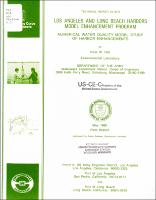Please use this identifier to cite or link to this item:
https://hdl.handle.net/11681/25646| Title: | Los Angeles and Long Beach Harbors Model Enhancement Program : numerical water quality model study of harbor enhancements |
| Authors: | Hall, Ross W. |
| Keywords: | Harbors--Hydrodynamics--Environmental aspects Harbors--California--Los Angeles Harbors--California--Long Beach Water quality--California--Mathematical models |
| Publisher: | Environmental Laboratory (U.S.) U.S. Army Engineer Waterways Experiment Station. |
| Series/Report no.: | Technical Report;EL-90-6 |
| Abstract: | Future plans for the Los Angeles and Long Beach Harbors enhancement include dredging and new landfill. The enhancements may affect water quality through changes in water circulation and flushing. The major water quality concern was possible depression of dissolved oxygen (DO) in poorly flushed, deepened navigation channels. A comparison of flushing and DO between existing (Base) and an enhanced plan (Scheme B) was conducted. A three-dimensional (3-D) numerical water quality model (WQM) was adapted to process the output from the 3-D hydrodynamic model CH3D in order to transport the water quality constituents. The overlaid WQM grid required that the hydrodynamic data be spatially averaged, and the WQM kinetic interactions allowed the data to be temporally averaged. The averaging resulted in 92 percent fewer computational cells in the WQM and allowed a 1,400-percent increase in the time step while maintaining computational stability. The reduction in spatial and temporal resolution greatly reduced computer time for the WQM. Flushing studies consisted of inserting a tracer and observing its movement and dilution with time. The flushing studies identified areas within the harbor that exhibited decreases in flushing. Areas that exhibited decreased flushing were selected for more detailed characterization during subsequent DO simulations. The flushing studies revealed a flow reversal in the main channel from counterclockwise in the Base condition to clockwise in the Scheme B enhancement, and the enhancement accelerated its flushing. The WQM formulation included the state variables DO, carbonaceous biochemical oxygen demand, ammonia nitrogen, nitrite plus nitrate nitrogen, algal biomass, and orthophosphate. Processes directly affecting DO included tidal circulation; phytoplankton oxygen production and growth as a function of light and nutrients, respiration, and nonpredatory mortality; sediment oxygen demand; biochemical oxidation of organics; nitrification; and reaeration. The predicted DO was nearly equivalent in Scheme B compared with existing conditions. Measured and simulated results were in general agreement. Discrepancies in agreement are attributed to insufficient initial condition data and the contribution of Los Angeles River flows that were not modeled. |
| URI: | http://hdl.handle.net/11681/25646 |
| Appears in Collections: | Technical Report |
Files in This Item:
| File | Description | Size | Format | |
|---|---|---|---|---|
| TR EL-90-6.pdf | 14.84 MB | Adobe PDF |  View/Open |